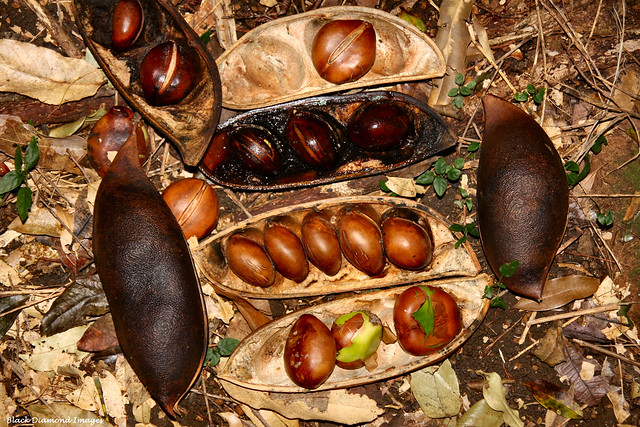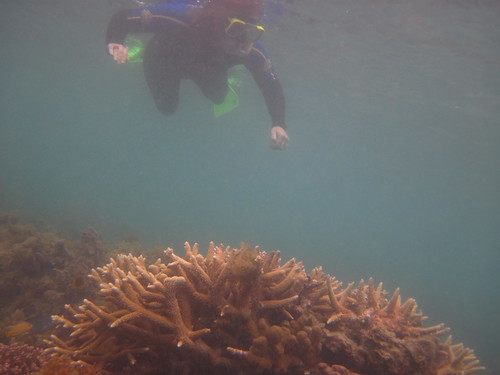These wonderful images, and many more, come from Black Diamond Images :
This set is Seeds/Fruit of the Australian Rainforest
This set is Seeds/Fruit of the Australian Rainforest
Do yourself a favour and go see the wonderful sets of images at the sites above or here at Black Diamond images - Zenfolio.
 |
Black Diamond Images: Castanospermum australe - Black Bean, Morton Bay ChestnutALL IMAGES COPYRIGHT All Rights Reserved. Contact -bdimages(at)wc.net.au Family : Fabaceae The seeds should be regarded as poisonous and not eaten as there are numerous well documented cases of poisoning. Aborigines have been reported as eating the seeds but only after careful preparation involving leaching in water and roasting. Everist (1974). More info here. |
The wonderful people at Wild Mob whom I wrote about in last week's post: sent me this link to the Royal Botanic Gardens, Sydney website today where there are some excellent plant science programs in place. Thanks Randall!
Having spent a large part of my life living in NSW I've some familiarity with species from that State. That said ... the northern NSW coastal area where I grew up is sub-tropical and somewhat similar to the south-east Qld region where I am now. Borders dont count for much in one sense... in other ways they do.
Last year, based at the Brisbane Botanic Gardens, I was interested to discover that during World War II the Qld State Govt's funding pressures were such that they handed over the running of the Gardens to the City Council... an unusual arrangement for such a large institution. An obvious resulting challenge is the Gardens have not exactly been the funding priority of State Govt in the way they might have been. Where the Herbarium is State Govt run and located on the grounds of Mt Coot-tha alongside the Garden's Administration buildings ... its a completely separate entity. Facilities and programs a Govt might undertake differ to those a Council will determine necessary nor have the capacity to fund. The Qld Seeds for Life project and Seed Lab would be an obvious area that could benefit greatly from Government involvement... especially as the collections come from across Queensland and are shared between the Millennium Seed Bank in the UK and the Qld Seed bank.
The Royal Botanic Gardens in Sydney is where I will focus this post. It appears to be an excellent facility on many levels... not the least of which is the extensively well-developed programs for Plant Science - if you click on the categories listed above under the Science heading you can read more on what is taking place there.
This is a lively and important campaign from the RBG in Sydney:
This is a lively and important campaign from the RBG in Sydney:
 |
It is estimated that worldwide up to 50% of plant species face extinction.That's a significant threat to our planet. Every plant performs vital functions that make life on earth possible. How you can helpDonations will help us to protect an endangered plant species. By joining the Save a Species campaign today, you will help us protect our planet. and give a gift to someone special. However you decide to get involved, you will be helping to preserve plants and the important roles they perform. How does it work? DNA to prevent the loss of plant species from ecological habitats.
Through this network the NSW Seedbank has helped bank 10% of the world's plant species and is committed to reaching 25% by 2020. Our Seedbank is targeting plants most at risk from climate change and human activities to ensure the powerful blueprints contained in plant DNA aren't lost forever.
support of the NSW Seedbank and the Royal Botanic Gardens Foundation. Anne Geddes' latest book is Beginnings - an exploration of new life. |
To read more about one of the conservation adventure programs from Wild Mob click here and see what they invite you to join in with! Image below is a group who have volunteered with Wild Mob...























Wonderful post. I have participated in invasive weed removal in the Pacific NW. It is hard work! (English Ivy is transplanted from local gardens to forest. It goes crazy and chokes out trees and other native plants.) People don't realize that by planting non native plants, that they can do damage to indiginous (sp?) landscapes.
ReplyDeleteWe also don't realize what we have lost until it is too late!
Oh, and the seed forms are very inspiring!
Yes I'm with you on that Mary... people dont realise... many see when something is gone and not before... and perhaps these days not even then!
ReplyDeletePart of what's so brilliant about the volunteering process is eyes are opened... on-site learning...things can be put in perspective!
"Show and tell" ... it makes a big difference to our understanding!
thanks for your words... I have an image of the forests of the U S North West being very dense, huge and hard to navigate even?
S
Hi Sophie,
ReplyDeleteHere is another link that your readers may find useful.
DATABASE INDEX of the Identifying Australian Rainforest, Plants trees and Fungi Flickr group which currently has 340 members
http://www.flickr.com/groups/australianrainforestplants/discuss/72157606451405999/#comment72157606451416793
Look down the list for Rainforest Fruits and further down for rainforest fruit by colour tags.
BD...
ReplyDeletethis is amazing... I will have to do a post when I can this week or very soon to ring this to people's attention.... WOW!
So impressive... thank you!
S